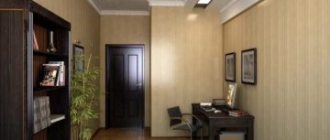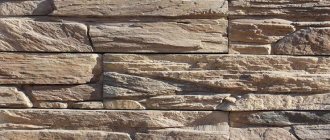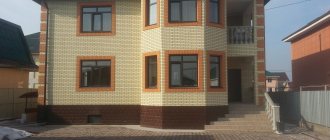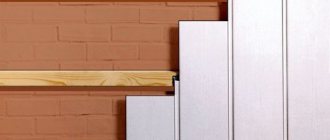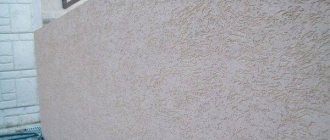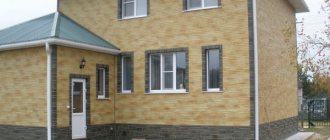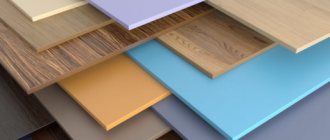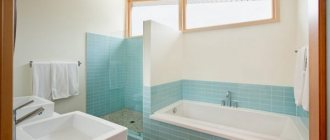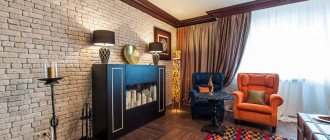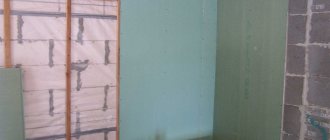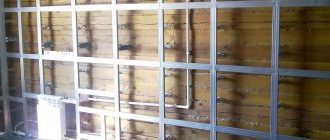Covering the base with panels
Finishing the foundation with plastic panels is a practical and inexpensive way to additionally protect and decorate the base. They also improve the thermal insulation of the building. Having a beautiful appearance and low weight, the panels are easy and quick to install. They imitate the appearance of various finishing materials. The technology is simple, so doing all the installation work yourself will not be difficult. To do this, it is enough to have minimal construction skills. A wide range allows you to choose the cladding of the desired texture and color.
What is a plinth
?
The base is the upper part of the foundation, which protrudes 30-70 cm above the ground surface. It can be made of the same building material as the underground part or built from other materials: brick, wood, stone. It can play an auxiliary role - if the foundation is strip, or decorative if the house is on stilts. If the house stands on a high pile-screw foundation, then with the help of basement panels you can turn the space between the ground and the floor of the house into another room - the ground floor.
Possible errors and ways to eliminate them
If the sheathing is installed incorrectly, the structure can be disassembled and reassembled . The same applies to the assembly of panels.
The material is separated and laid anew if there is a discrepancy somewhere. Panels on wet coupling may be damaged during dismantling.
Nuances:
- panels cannot be bent;
- if there is a protective film, remove it only after installation;
- You can only cut from the inside, not from the rib or from the face.
Why cover the base?
The lower part of the house, the one that comes into contact with the surface of the earth, experiences the severe destructive effects of weather changes. Flows of water in spring and autumn, winter frosts and heat in summer lead to the fact that the cement mortar from the brickwork is washed out, and the wooden structural elements turn into dust. Cracks and crevices appear on the walls of the basement, into which the cold wind blows, and toads and snakes can crawl in. To ensure that the building does not quickly collapse, the base must be sheathed with some durable and moisture-resistant material.
Installation technology
Covering the foundation with plastic panels is a fairly simple process, but there are a number of nuances that cannot be ignored. First of all, you should carefully study the instructions, which must be included; they contain basic recommendations and standards.
The process is divided into stages, and only the correct execution of all actions makes it possible to obtain the desired result.
Preparation
Preparation is mandatory because it helps to avoid problems in the future. It is as follows:
- The condition of the foundation is assessed. If the structure was recently erected, then there should be no noticeable defects. Things are much more complicated with old buildings. It is important to consider that installation cannot be carried out on the previous cladding, so it must be completely cleaned off.
- Cracks and crevices are an alarming sign; in the presence of such serious defects, the structure needs additional strengthening. If the damage is superficial, then they are covered with a suitable solution.
- The base is treated with special compounds that will prevent the formation of mold and mildew.
Before starting work, the availability of everything necessary is checked.
Frame installation
Installation of the frame can be carried out in different ways. The method using a metal profile is considered the most reliable. You should also decide in advance whether there will be insulation. Foam plastic or penoplex can be used as a thermal insulation material. Mineral wool is not very suitable, since it absorbs moisture well, after which it loses its properties.
Lathing installation process:
- To ensure the necessary ventilation, the insulation layer is laid on a special glue, and a disc-shaped dowel is used for fixation. The joints are coated with polyurethane foam.
- Marking is being carried out. Along the drawn lines, hangers are attached to the surface, and a profile is attached to them.
- Spacers are installed separately to ensure the necessary reliability.
- If a starting bar is included with the panels, then it is fixed at some distance from the ground.
Covering the foundation with plastic panels not only decorates the house, but also has a great effect on protecting and insulating the foundation. The foundation is protected not only from physical damage, but also from weather conditions. Finishing the base with plastic is simple and quick.
Plastic panels for covering the base
Requirements for plinth cladding
The following requirements apply to the cladding of the base:
- Strength and durability of facing materials;
- Maximum permissible load on the foundation;
- Aesthetic appearance;
- Installation technology.
Not only the quality of the material matters, but also how the installation of the plinth panels was carried out. If gross mistakes were made when working with siding, then no matter how high-quality the material is, the base will soon begin to collapse.
All building materials that will be used for finishing must be of high quality. Chips, scratches or cracks are not allowed on their surface. The work was carried out in accordance with the technology and according to the instructions. It is important to pay attention to the quality of preparation of the base surface for finishing.
Carrying out preparatory work
Before you start installing the panels for the plinth, you need to prepare its surface accordingly. In this case, the following work is performed:
- using a dampened rag or broom, clean the foundation of the house from dirt: dust, earth clods, old paint (a solvent is used for this) and other things;
- dismantle the protruding parts of the base;
- level the surface of the base with plaster, sealing existing gaps, recesses, cracks;
- prime the prepared section of the foundation to increase its strength and create an additional moisture-proofing coating;
- if the sheathing material is a wooden beam, then it is treated with an antiseptic and a moisture-proof coating is applied, after which it is dried.
Installation on a wooden beam
Foundation panels require almost perfect leveling of the base surface before installation. If necessary, even plastering along beacons is used; the base itself is pre-primed with a deep penetration compound. To prevent the bars from deforming when drying, they are dried indoors at room temperature.
Types of plinth panels
Base panels are made of metal, plastic, stone and composite materials (artificial stone). The panels differ in size, pattern, color, locking system, and installation method. Such panels are also called siding, but unlike conventional wall panels, they are thicker and stronger.
Sometimes, instead of base panels, corrugated sheets are used. Sheathing with corrugated sheets has its advantages and disadvantages. It is cheap and easy to install, but aesthetically it is inferior to other finishing materials. If the appearance of the building is not so important, then it can be used as panels.
Under the stone
Stone-look plastic panels are sheet material measuring 70-120 cm (the size depends on the manufacturer), on the front surface of which there is a relief pattern imitating stone. However, panels can be made not only from PVC. The material can be artificial or natural stone, which is small in thickness and looks like tiles. On the back side it is flat, and on the front side it is convex.
Under the brick
This is another common pattern for finishing a base. If the base is brick, then it seems that the brick finish is pointless, but this is not the case. The purpose of covering the base with panels is not decorative, but practical - to increase the service life of a private house, to protect the premises from dampness and cold. Brick siding can be made of metal, plastic or baked clay.
Never buy panels made from foam material. Despite its greater thickness, it is the least durable, sensitive to scratches and solar radiation.
Step-by-step instructions for do-it-yourself cladding
How to cover the base with plastic panels? Stages of work:
- Installation of sheathing. Vertical guides are installed first; the distance between them should not exceed 30-40 cm. Using a level, horizontal guides are laid from the corner of the building. It matters how evenly the sheathing is installed - the position of the panels depends on it.
- Insulation is placed inside the sheathing. The ideal option is polystyrene foam or mineral wool.
- A waterproofing film can be laid on top.
- To check the correct installation, a nail is driven in on both sides of the wall at the lower level. The thread is stretched between them at the same distance from the wall.
- Installation of panels begins from the lower left corner. It is recommended to first make the connection directly at the corner on both sides. The ribs should overlap each other slightly to prevent moisture from penetrating into the joints.
- Further along the plinth wall, the panels are connected depending on the method of fastening. Using clamps or screws, as recommended by the manufacturer.
- The joints and gaps (if any) are treated with sealant.
- A barrier with a slope for precipitation is placed on the upper part.
- The vents are cut out and covered with bars.
- The corners are covered with special corners.
Before starting work, read the instructions from the manufacturer.
Installation options using liquid nails or glue for cladding the base can be used for non-residential premises.
Together with the sheathing, the wall is cleaned and the panels are glued directly onto it, without insulation or waterproofing. Suitable for warm regions and elevated buildings.
Necessary tools and materials for installation
To install basement panels with your own hands, in addition to siding panels, you will need various building materials and tools.
- Metal profiles;
- Insulation;
- Vapor barrier film;
- Screws;
- Dowels with a length of at least 100 mm;
- Screwdriver;
- Drill with a pobedit drill bit and a drill bit designed for metal;
- Grinder with a disc for cutting plastic, metal and stone;
- Level;
- Scissors.
The canopy over the protruding part of the base can be made from sheets of galvanized steel, plastic, or use special tiles to match.
Do not use wooden beams to create sheathing. For wooden products, the danger is not only high humidity, but also fungus, which is not always noticeable when purchasing.
How to install panels
In order to cover the base, you must first fill the sheathing. The sheathing is made either from wood or from a profile. It is fixed with special fasteners. In the process of filling the sheathing, it is very important to carefully maintain even vertical and horizontal lines to prevent the appearance of unevenness and distortion.
The next step (optional) is insulation. There are many materials that can be used as insulation. The classic option would be polystyrene foam or mineral wool, the highest quality is Izhevsk polyurethane foam. The insulation sheets are fixed with special fasteners (parachute anchors) so that the vertical seams between the slabs of one row do not coincide with the next row.
Insulating the basement of a house with polystyrene foam
If there is no need for insulation (or there is no money for insulation), then it can not be produced.
A new necessary step is to attach a waterproof “breathable” film to the sheathing to protect the foundation from flooding. It can be secured with ordinary nails, construction (reinforced) tape or a special stapler.
Next, the fittings are secured. It is fastened with self-tapping screws, their diameter is determined by the mounting holes in the fittings.
After fixing the fittings, the panels are installed. They can be attached to special strips or simply screwed to the sheathing with self-tapping screws. When fastening with self-tapping screws, it is necessary to take into account wind loads and loads caused by precipitation. Each new panel must fit clearly with the previous one. You can cut off the excess with a construction knife, hacksaw or grinder. After installing the panels, a special canopy is attached to the walls to protect against rain and snow. After that, the seams between the panels are grouted (if panels that do not overlap are selected). This completes the installation of the panels.
Scheme of fastening plinth panels
Technology of finishing the base with panels
The technology of cladding facade panels is simple, but it will require a lot of time and effort. The main thing is to prepare the surface of the base for finishing. Work can only be carried out during the warm season in dry weather. The base must first be cleaned of dust, dirt, and moss (if it appears on it). Below are step-by-step instructions for performing installation work.
- They take measurements and calculate the volume of materials needed for the work.
- A frame for the panels is created. The frame is made of metal profiles. First, the upper and lower metal profiles are attached to the wall, parallel to the ground (blind area). This is done using dowels, having previously drilled holes for them in the base. Then vertical beams are attached at a distance of 70-120 cm from each other. There should be a crate.
- Insulation is placed in the space between the frame beams. It can be ISOVOL or PENOPLEX.
- Stretch a vapor-proof film over the frame.
- The panels must be secured to the frame using screws.
- The panels are connected to each other using a special tongue-and-groove locking system. For reliability, each sheet is attached to the frame with screws.
- Planks are installed at the corners.
- On top, you need to mount a canopy around the perimeter of the house above the top edge of the panels.
If a blind area has not been made around the perimeter of the house or there are no resources to create one, then a simple drainage system must be installed around the perimeter of the house. You can make it yourself from pipes cut to the diameter and laid close to the bottom of the base.
Some houses have ground floor windows in the basement walls. They also need to be trimmed. For this purpose, special window sills made of plastic are used.
Installation process
The installation of panels on the base of the house takes place in several stages: first, the sheathing is installed, and then the cladding is installed. The frame is created according to the following algorithm:
- choose the material: metal profile or wooden beam;
- fix the guides at the required distance, controlling with a level their evenness in the horizontal and vertical planes.
After installing the frame, if necessary, the base is thermally insulated using technology.
Next perform the following actions:
- attach a waterproof film to the created frame using tape or nails, or staples (using a stapler);
- fix the fittings with self-tapping screws selected according to the diameter of the holes in it;
- they cover the basement of the house with plastic panels;
- fasten ebb tides to the walls;
- grout joints when used for finishing panels mounted without overlap.
Result of the work
All work, both preparatory and basic, can be easily done with your own hands. It is imperative to follow the instructions for the product to ensure high quality results.
Covering a pile foundation with plinth panels
Houses on stilts do not have a basement. To prevent the building from looking ugly, an artificial plinth is created underneath it. It is made either from brickwork or sandwich panels. The technology for covering a pile-screw foundation with plastic panels is practically no different from covering a standard base. The frame is attached to the piles from the outside or placed in the space between them (under the house).
Advantages and types
The advantages of plastic panels are:
- Attractive view. Base panels (also called façade panels) imitate stone or brickwork with a high degree of realism. It is difficult to distinguish them from natural material even at close range;
- Light weight. The cladding does not load the supporting structures of the house;
- The panels provide ventilation to the base and do not prevent the escape of water vapor;
- Installation is simple and can be performed by untrained people;
- In parallel with the installation of the sheathing, insulation is installed;
- A significant decorative effect is achieved.
There are two main types:
- Wall siding. These are long narrow slats that are used to decorate the walls of a house;
- Basement siding. The panels have a shape close to rectangular. They are installed on the base part, but are often used for complete wall cladding.
The main differences between wall and basement types of siding are:
- Form;
- Simulated material. Wall cladding is made to look like wood - timber, logs, ship planks. Basement panels replicate brick or stone masonry types.
The plastic is elastic and can easily withstand light impacts without causing dents. The disadvantages of the material are:
- High coefficient of thermal expansion, requiring compliance with fastening rules;
- Low winter temperatures make plastic brittle and poorly resistant to mechanical stress.
Users positively evaluate plastic panels for their successful set of performance qualities and beautiful appearance.
Main manufacturing companies
Below is a list of manufacturers of siding panels for finishing the facade of private houses.
- Grand Line. Siding for finishing the base produced by the Grand Line company is one of the most common building materials for covering the protruding part of the foundation. The wealth of colors and textures, as well as an affordable price, made it one of the market leaders.
- Canadaridge basement siding. The effectiveness of the technologies used in the production of Canadaridge basement siding has been successfully tested in the Canadian and Russian climate. The panels are cast under high pressure and painted during the casting process. This ensures uniformity of the structure and color of the products. There are about seven color options. The surface of the panels is resistant to fading in the sun. The company provides a 30-year quality guarantee for its products.
- Basement siding Fineber. Facade panels Fainbir has a large assortment of panels, different colors and textures. It includes 6 types of stone panels and 2 types of brick siding. The relief pattern, its color and texture exactly reproduce the pattern of brick and some types of natural stone (granite, marble). FineBer panels are resistant to mechanical stress, precipitation, and do not fade in the sun.
- Facade panels Tecos (ImaBeL). The facing panels for finishing the plinth, manufactured by Tecos, are also of high quality. The durability of the products makes it possible to use them not only as a decorative element, but also to protect the most vulnerable areas of the facade of the house.
- Zodiac facade panels. Zodiac is a domestically produced facing material with a multilayer structure. Zodiac products are environmentally friendly and meet international quality standards. This company has appeared on the building materials market recently, but has already won high praise from builders and designers.
These are the most popular brands of plinth panels. However, we should not forget about local manufacturers of various building materials. They are less known, but their products can be no less high quality. It should be taken into account that the quality of the plinth cladding is affected not only by the quality of the panels, but also by other building materials that are used during installation. The strength of the sheathing and fastenings depends on their quality. If they are of low quality, the casing may fall off.
Plastic panels: product features
The popularity of plastic panels for foundations is due to their low cost. They are among the most inexpensive materials intended for finishing the base (the upper foundation part located above the ground surface). This part of the base, which performs load-bearing functions, must at the same time have a beautiful appearance.
Foundation plastic panel coverings are siding for the basement. It differs from its facade counterpart in the following characteristics:
- higher strength;
- greater thickness: for basement siding this parameter reaches up to 3 mm, and for façade siding – up to 1.5 mm.
Products of different colors and textures are produced for foundation cladding. Often a material that imitates stone or brick is used for finishing.
Product range
The following types of plastic coatings for stone have become widespread:
- vinyl;
- acrylic;
- fiber cement;
- sandwich panels.
Compared to natural stone, they are much easier to clean and do not require special treatment.
Basement siding is characterized by the following advantages:
- quick installation;
- long service life of more than 50 years;
- does not require additional treatment with protective agents;
- small price;
- resistance to temperature fluctuations, moisture, and sunlight;
- sufficient strength;
- the ability to restore its original shape after impacts (plasticity);
- a wide range allows you to choose the required color and texture, size of parts, finishing;
- chemical and biological resistance;
- provides hydro- and thermal insulation.
There are significantly fewer disadvantages. These include:
- not permeable to air, which prevents its natural circulation and promotes the formation of condensation on the surface of the base or insulation;
- expansion with increasing temperature.
The first disadvantage is eliminated by installing a ventilated foundation.
The expansion is compensated by leaving gaps of small width. Also, the screws are not screwed in completely.
Models of cladding are available that can be painted and have designs with relief.
Low cost and excellent performance have led to the widespread use of this plastic material for finishing bases. The desired type of cladding can be easily selected in hardware stores.
How to choose the right one
A large assortment of siding for finishing the base creates a problem of choice. How to choose what is best in terms of price and quality? The answer to this question depends on the climate in the region, the appearance of the building, and the financial capabilities of the buyer. A few tips will be helpful.
- The harsher the climate in the region, the thicker and more durable the siding should be.
- There should be no scratches or chips on the surface, especially if the panels are made of metal.
- Cheap siding is a low-quality material. Cheapness means that low-grade raw materials were used in production, which means the panels will not be strong enough and will not last long. This type of building material is not worth purchasing.
- When purchasing expensive types of basement siding, the buyer must demand a quality certificate from the seller, since there is a high risk of purchasing a fake.
- You must follow the installation instructions. Although self-installation is simple, if the work is done carelessly, then the service life of the base will be shorter.
If you don’t have confidence in your own abilities, then it’s better to entrust all the work to professionals. The price for finishing the basement depends on the region, the brand of building material (imported American and European brands are more expensive) and the qualifications of the workers.
Pros and cons of use
Advantages:
Light in weight.- Simple installation, does not require preparation or leveling of walls.
- They do not allow moisture to pass through.
- Keep warm.
- There are fireproof options.
- Many colors and textures.
- Inexpensive.
- Easy care.
Flaws:
- They do not tolerate mechanical damage.
- When burned, it releases toxic substances and can cause poisoning in a fire.
- Not recommended for northern regions; it may crack in the cold.
You will find a lot of important and useful information about plinth panels and their installation in this section.
Prices for materials and installation work
The average price for plinth panels ranges from 250 to 750 rubles per square meter. The price depends on the popularity of the brand, the type of material from which they are made and the complexity of the pattern. The cheapest panels are made of plastic, the most expensive ones are made of natural stone. A galvanized profile of standard length will cost 100 rubles per piece.
Installation costs per square meter vary by region. The cost may also be affected by the qualifications of the workers. On average, the price can vary from several to several hundred to several thousand rubles. High-quality work by a team of workers will cost at least 5 thousand rubles per square meter. The team carries out all the necessary work, from measuring to installing the canopy and drainage system. After the measurements, the foreman calculates the full amount for the entire work. You can do the installation of basement panels yourself, or you can hire a team of workers. The first option is suitable for those who have enough free time and skills in working with basic construction and installation tools: grinder, drill, level, etc. The second is suitable for those who want to get a high-quality result quickly, effortlessly and for those who can afford it financially.
Types of finishing materials
Foundation finishing panels are made by many manufacturers. You can choose natural stone or give preference to clinker tiles. Vinyl siding is also no less popular. Many property owners prefer modern sandwich panels. Each façade finishing option has its own advantages and can be used for cladding the plinth.
- Natural stone. This is an expensive material. Before finishing the base with natural stone, it is necessary to carry out preparatory work. Cladding the base with stone should be taken into account at the design stage of the house. Then the foundation will have the necessary margin of safety.
- Clinker tiles. For those who like the look of brickwork, it is worth taking a closer look at the option of cladding the base with clinker tiles. Visual appeal and good thermal insulation are the main advantages of this type of cladding.
- Profiled sheeting. Another popular facing material, which is also often used for external fencing. There are enough advantages of corrugated sheeting: affordable price, quick installation, different sheet sizes. Manufacturers offer corrugated sheeting in various colors. The material may differ in wave height.
